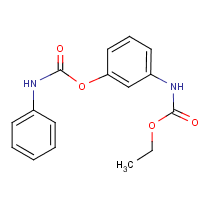Desmedipham
Agent Name
Desmedipham
CAS Number
13684-56-5
Formula
C16-H16-N2-O4
Major Category
Pesticides

Synonyms
3-((Ethoxycarbonyl)amino)phenyl phenylcarbamate; 3-(Aethoxycarbonylaminophenyl)-N-phenyl-carbamat [German]; 3-Ethoxycarbonylaminophenyl-N-phenylcarbamate; Bentanex; Betanal AM; Betanal AM 11; Betanex; Carbamic acid, (3-(((phenylamino)carbonyl)oxy)phenyl)-, ethyl ester (9CI); Carbanilic acid, m-carbaniloyloxy-, ethyl ester; Carbanilic acid, m-hydroxy-, ethyl ester, carbanilate (ester) (8CI); Desmediphame [ISO-French]; EP-475; Ethyl (3-(((phenylamino)carbonyl)oxy)phenyl)carbamate (9CI); Ethyl 3'-phenylcarbamoyloxycarbanilate; Ethyl 3-phenylcarbamoyloxyphenylcarbamate; Ethyl m-hydroxycarbanilate carbanilate (ester); Ethyl phenylcarbamoyloxyphenylcarbamate; SN 38107; SN 38170; SN 475; Schering 38107; Synbetan D; Ethyl meta-hydroxycarbanilate carbanilate; [ChemIDplus]
Category
Herbicides, Carbamate
Description
Colorless to off-white solid; [Reference #1]
Sources/Uses
Used as selective post-emergence herbicide for sugar beets; Also registered for “Special Local Needs” in Washington state for table beets and Swiss chard seed production; [Reference #1]
Comments
A skin sensitizer in guinea pigs; Causes methemoglobinemia and elevated liver enzymes in high-dose animal experiments; [Reference #1] May cause irritation; [Aldrich MSDS]
Reference Link #1
Biomedical References
Exposure Assessment
Vapor Pressure
3E-09 mm Hg
Lethal Concentration
LC50 (rat) > 7,400 mg/m3
Adverse Effects
Skin Sensitizer
Yes
Methemoglobinemia
MetHgb is secondary toxic effect
Hepatotoxin
Hepatoxic (a) from occupational exposure (secondary effect) or (b) in animal studies or in humans after ingestion
Diseases, Processes, and Activities Linked to This Agent
Diseases
Occupational diseases associated with exposure to this agent:
Processes
Industrial Processes with risk of exposure: